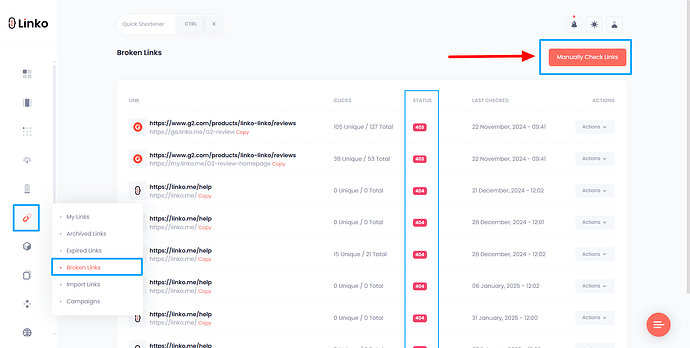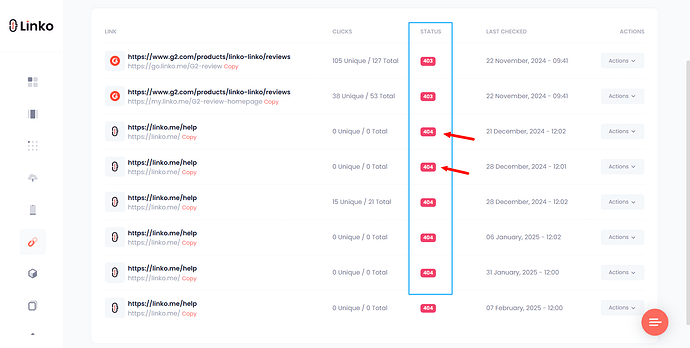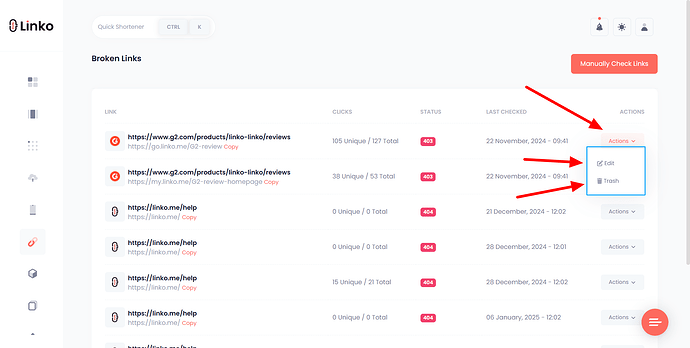What is a Short Broken Link?
A short broken link is a URL that no longer directs visitors to its intended destination.
Typically, these links return a 404 error, indicating that the page cannot be found.
Why You Need to Monitor and Check Your Short Links
Monitoring your short links helps to:
-
Maintain User Experience: Avoid frustrating visitors with dead ends.
-
Improve SEO: Search engines favor working links over broken ones.
-
Track Performance: Identify which links need updating or removal to maximize click-through rates.
How Do I Check If I Have Broken Short Links?
Follow these steps to perform a broken link check in your Linko account:
Note: Broken link management is available on Business and Agency Plans.
-
Navigate to the left sidebar and scroll down.
-
Hover over the “Link” icon.
-
Select “Broken Links” from the list.
-
Click the “Manually Check Links” button.
-
Wait for the system to scan and list any broken links.
This process quickly identifies which short links are failing so you can take action.
How Do I Fix If I See a Broken Short Link?
Before making any changes, check the Status of your link on the dashboard:
-
404 Status: Indicates the link is broken.
-
Other HTTP Codes: May signal a different issue (e.g., redirection or server error). (Mostly they are non-critical)
If a link shows a 404 status, you have two options:
-
Delete the short link if it isn’t receiving many clicks or is no longer needed.
-
Edit the short link and update its destination URL to the correct address.
Common HTTP Status Codes
Below is a list of popular HTTP status codes grouped by their response class, each with a one‐line explanation of what it means and whether it’s considered critical.
1xx: Informational
-
100 Continue – The server has received the initial part of the request and the client should continue sending the rest; generally not critical.
-
101 Switching Protocols – The server is switching to the protocol the client requested; non-critical and rarely seen in everyday use.
Non-critical - ignore it.
2xx: Success
-
200 OK – The request succeeded and the server returned the requested data; standard and not critical.
-
201 Created – The request has been fulfilled and resulted in a new resource being created; a positive outcome and non-critical.
-
202 Accepted – The request has been accepted for processing but is not completed yet; generally informational and not immediately critical.
-
204 No Content – The server processed the request successfully but returned no content; normal for some operations and not critical.
Non-critical - ignore it.
3xx: Redirection
-
301 Moved Permanently – The resource has been permanently moved to a new URL; important for SEO and caching but not a server error.
-
302 Found – The resource is temporarily located at a different URL; common for temporary redirects and not critical.
-
303 See Other – Directs the client to retrieve the resource via a GET request at another URL; non-critical and used for redirection after a POST.
-
304 Not Modified – Indicates that the resource has not changed since the last request, allowing cached versions to be used; not critical.
-
307 Temporary Redirect – Similar to 302, this code tells the client to repeat the request at a different URL while preserving the request method; non-critical.
-
308 Permanent Redirect – Like 301, but keeps the original HTTP method; important for maintaining request consistency, yet non-critical.
Non-critical - ignore it.
4xx: Client Error
-
400 Bad Request – The request is malformed or contains invalid parameters; critical if persistent as it blocks proper communication.
-
401 Unauthorized – Authentication is required and either missing or incorrect; critical for access control.
-
403 Forbidden – The server understands the request but refuses to authorize it; critical when access is denied.
-
404 Not Found – The requested resource could not be found on the server; common and usually non-critical but can affect user experience.
-
405 Method Not Allowed – The HTTP method used is not supported by the resource; indicates a misconfigured request and is moderately critical.
-
408 Request Timeout – The server timed out waiting for the request; can be critical if it happens frequently, affecting performance.
-
429 Too Many Requests – The client has sent too many requests in a given timeframe; critical in protecting the server from abuse.
In case of short links, only 404 is critical.
5xx: Server Error
-
500 Internal Server Error – A generic error when the server encounters an unexpected condition; highly critical as it disrupts service.
-
501 Not Implemented – The server does not support the functionality required to fulfill the request; critical as it indicates missing features.
-
502 Bad Gateway – The server received an invalid response from an upstream server; critical when it disrupts client access.
-
503 Service Unavailable – The server is temporarily unable to handle the request, often due to overload or maintenance; critical when persistent.
-
504 Gateway Timeout – The server did not receive a timely response from an upstream server; critical as it indicates network or server issues.
-
505 HTTP Version Not Supported – The server does not support the HTTP version used in the request; generally non-critical and rarely encountered.
Non-critical - ignore it.
FAQs
How often should I check my broken links?
Regularly, such as once a week, to ensure a smooth user experience and optimal SEO.
Can a link show an error other than 404 and still be fixed?
Yes. Links showing codes like 403 or 503 are not critical and you can ignore them.
What happens if I delete a broken short link?
The link is removed permanently, so ensure it isn’t generating significant traffic before deletion.
Can I edit a broken short link to fix it?
Absolutely. Editing the link to update the destination URL will fix the broken link, provided the new URL is valid.


